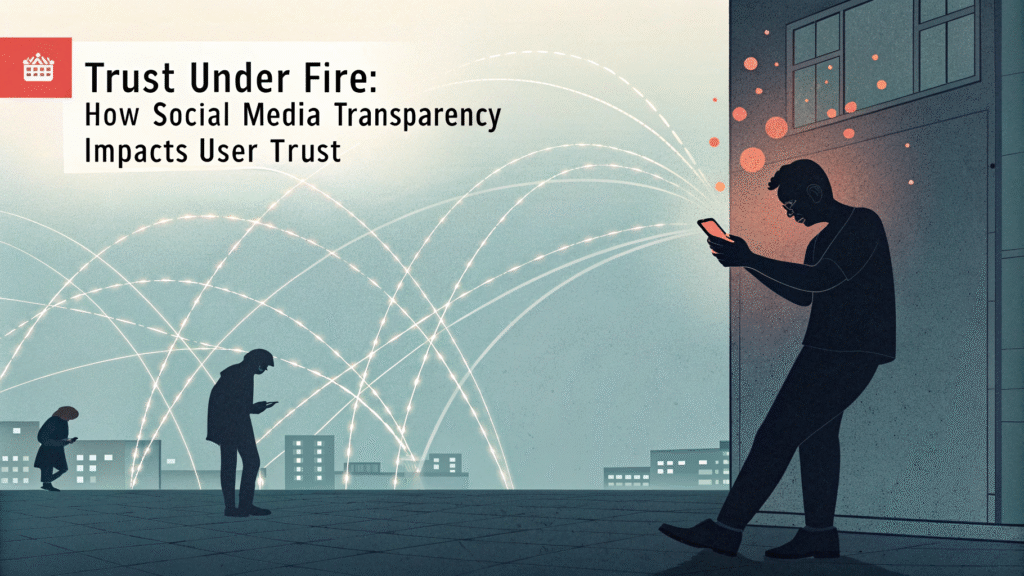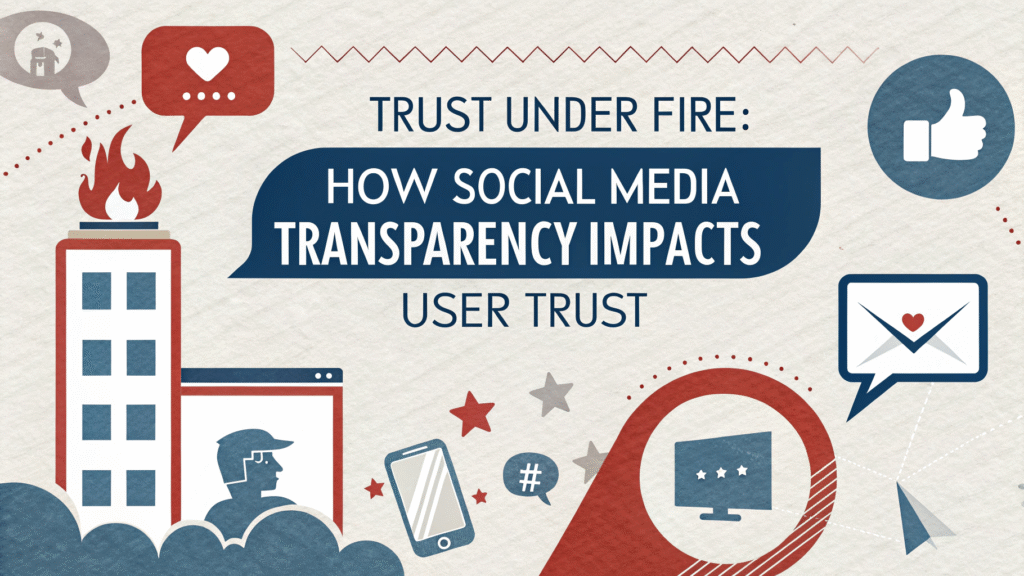
Introduction
Every day, billions of us log in to social media, but one pressing question arises: how does social media transparency affect user trust? This question lies at the heart of a growing debate that challenges the foundations of these platforms. For entrepreneurs, marketers, and content creators, this isn’t an abstract discussion; it’s a pressing business reality. When users doubt the content they see or the motives behind it, building authenticity and engaging an audience becomes significantly harder. This article explores the transparency debate, its impact on business, and strategies to build a more trustworthy and authentic brand
History & Evolution: Social Media Transparency and Trust Over Time
The transparency debate has evolved alongside social media itself. In the beginning, platforms like Six Degrees and Friendster were relatively simple—digital rolodexes focused on connecting friends. The early web celebrated openness.
- The Rise of the Feed (Mid-2000s): The introduction of the news feed on platforms like Facebook marked a pivotal shift. Algorithms began curating what users saw, moving from a chronological stream to an engagement-driven one. This was the first step toward opacity; users could no longer see everything from everyone.
- The Data Explosion (2010s): As social media became advertising behemoths, the collection and use of user data intensified. The Cambridge Analytica scandal in 2018 was a watershed moment, catapulting the transparency debate into the mainstream by revealing how personal data could be exploited for political manipulation.
- The Content Moderation Era (2020s): Recent years have been defined by intense scrutiny over how platforms moderate content. Decisions about banning accounts, labeling misinformation, and defining hate speech have sparked fierce debates about the consistency and transparency of these policies.
Alt text: A visual history of the social media transparency debate, highlighting key shifts in platform design and data usage.
Audience & Demographics: How Social Media Transparency Shapes Trust
The transparency debate resonates differently across various groups, each with unique concerns and stakes in the outcome.
- Everyday Users: The general public is increasingly aware of how their data is used and how algorithms shape their reality. Surveys show declining trust in social media companies, with many users feeling they have little control over their experience.
- Businesses and Marketers: For brands, a lack of platform transparency creates significant challenges. Algorithm changes can decimate organic reach without warning, and advertising metrics can sometimes feel like a “black box.” Consequently, building a sustainable strategy is difficult.
- Regulators and Policymakers: Governments worldwide are responding to public pressure with new legislation aimed at forcing greater transparency around data practices, political advertising, and content moderation (e.g., the EU’s Digital Services Act).
- Academics and Researchers: This group pushes the transparency debate forward by studying platform impacts on society. However, they often face barriers in accessing data from the platforms themselves, hindering independent research.
Key Features & Functions: Driving Social Media Transparency and Trust
The transparency debate centers on several core functions of social media platforms where opacity is most pronounced.
The Algorithmic Black Box: Transparency and Trust Challenges
- Content Curation: Platforms rarely disclose the exact factors that determine what appears in a user’s feed. This lack of clarity fuels suspicion that algorithms may promote divisive or misleading content because it generates more engagement.
- Advertising Targeting: While advertisers see results, the intricate details of how audiences are targeted and how ads are delivered remain largely opaque. This can lead to inefficient spending and brand safety concerns.
Data Usage and Privacy
- Data Collection: The extent of data collected—from location history to private messages—is often buried in complex terms of service. The transparency debate demands clearer, simpler communication about what data is taken and why.
- Third-Party Sharing: Users are increasingly concerned about how their information is shared with partners, advertisers, and other third parties. High-profile data breaches have intensified these concerns.
Content Moderation and Enforcement
- Inconsistent Policies: Platforms frequently update the rules governing acceptable speech, but they often apply them inconsistently, which leads to accusations of bias. Users and creators regularly demand a more transparent appeals process and clearer guidelines.
- Shadowbanning and Reach Limitation: The phenomenon of “shadowbanning”, where platforms secretly limit a user’s content without notification, has become a hot-button issue in the transparency debate. Creators and businesses need clear explanations when platforms suppress their reach.
Business & Marketing Potential: Leveraging Transparency for Growth
In an era of skepticism, transparency is no longer optional; it’s a powerful marketing tool. Businesses that embrace openness can turn the transparency debate to their advantage.
- Build Authentic Brand Loyalty: Consumers gravitate toward brands they perceive as honest and human. By being transparent about your processes, values, and even mistakes, you foster a deeper, more trusting relationship with your audience.
- Differentiate from the Competition: In a crowded market, a commitment to transparency can be a key differentiator. It signals that you value your customers’ intelligence and respect their right to know.
- Create More Effective, Trustworthy Advertising: Instead of relying solely on platform-targeting, use your owned channels (like email and your website) to communicate directly. Transparent marketing campaigns that explain your value proposition clearly often resonate more deeply.
- Turn Feedback into Fuel: Being open about customer feedback—both positive and negative—and showing how you act on it demonstrates a commitment to continuous improvement and customer-centricity.
Best Practices & Tips for Embracing Transparency
For entrepreneurs and marketers, here are actionable steps to navigate the transparency debate and build trust.
- Be Open About Your Data Practices: Clearly explain on your website how you collect and use customer data. Use simple language, not legalese. An easily accessible privacy policy builds confidence.
- Demystify Your Algorithms (Where Possible): If you use algorithms for recommendations on your own platform, explain the basic principles behind them. For example, “We suggest products based on your browsing history and items you’ve liked.”
- Communicate Changes Proactively: Whether it’s a price increase, a service outage, or a shift in content strategy, communicate early and honestly. This prevents speculation and shows respect for your audience.
- Show Your Work: Share behind-the-scenes glimpses of your team, your creative process, or your manufacturing. This humanizes your brand and builds a narrative of authenticity.
- Admit Mistakes and Outline Solutions: If something goes wrong, acknowledge it publicly. Explain what happened and what you’re doing to prevent it in the future. This approach can actually strengthen trust.
Challenges & Limitations
Despite the clear benefits, achieving full transparency is fraught with challenges.
- Competitive Secrecy: Platforms and businesses are often reluctant to reveal their “secret sauce”—such as proprietary algorithms—for fear of giving competitors an advantage.
- The Scale Problem: For global platforms, explaining exactly why they demote a specific post to each user poses a monumental technical challenge.
- Privacy vs. Transparency: There is a inherent tension between being transparent about content moderation and protecting user privacy. Revealing details about reports could expose whistleblowers or victims of harassment.
- Vulnerability to Manipulation: However, if algorithms were completely transparent, bad actors could more easily game the system to spread misinformation or spam. Consequently, this transparency could inadvertently make the problem worse.
Future Outlook
The transparency debate will continue to shape the future of social media and digital marketing.
- Increased Regulation: Expect more laws mandating transparency reports from platforms, detailing content removal actions, data requests, and political ad spending.
- Rise of “Explainable AI”: There will be a push for more interpretable algorithms that can provide understandable reasons for their decisions, moving away from complete black-box systems.
- Shift Toward Decentralization: Decentralized social networks (like Mastodon or Bluesky) promise user-controlled experiences and more transparent protocols, appealing to those dissatisfied with centralized control.
- Trust as a Key Metric: To build confidence, platforms could start creating and displaying “trust scores” for sources. Additionally, they could add features that let users see why specific content appears in their feed.

Conclusion
The question, “Is social media breaking our trust?” doesn’t have a simple yes-or-no answer. Instead, it has sparked a necessary transparency debate, forcing the digital ecosystem to confront these challenges.For businesses, this shift represents both a challenge and an immense opportunity. By proactively embracing transparency in your data practices, communication, and marketing, you can build a brand that stands out through its authenticity. The future of social media will belong to those who prioritize trust, turning the transparency debate from a point of contention into a foundation for stronger, more meaningful connections.